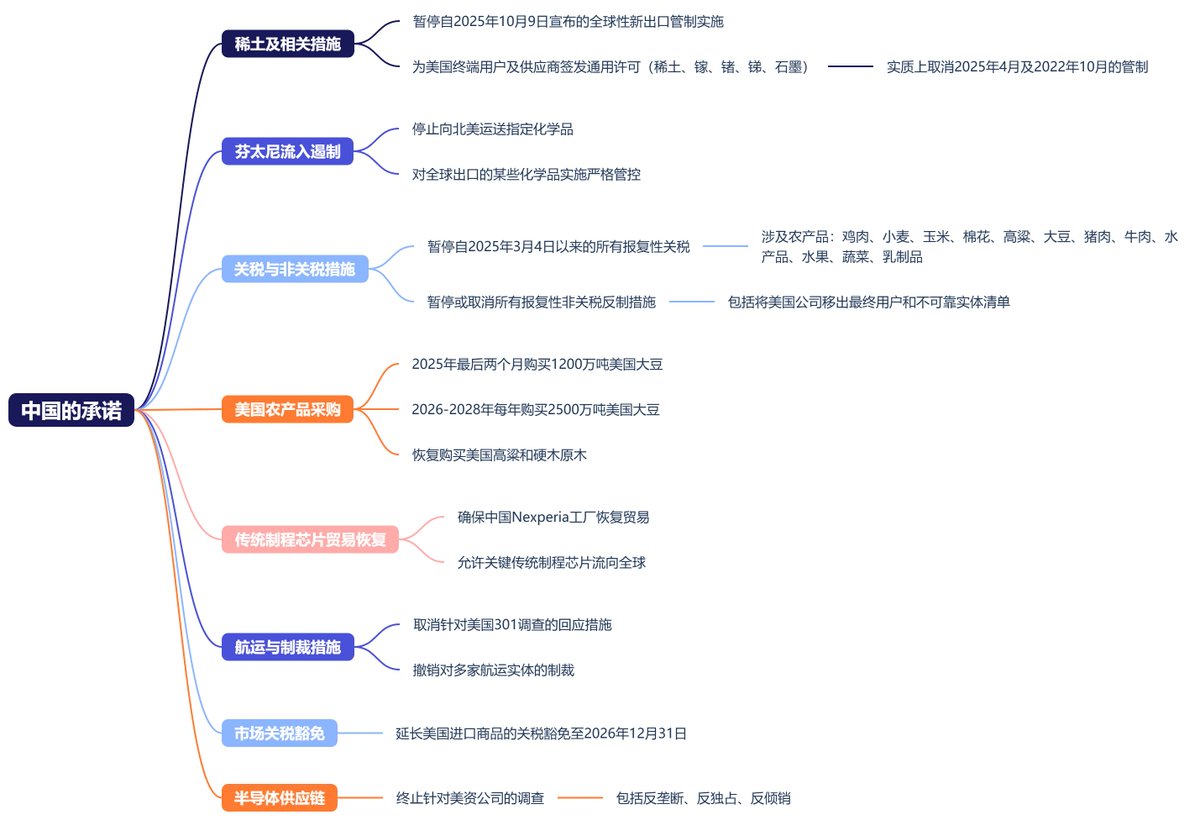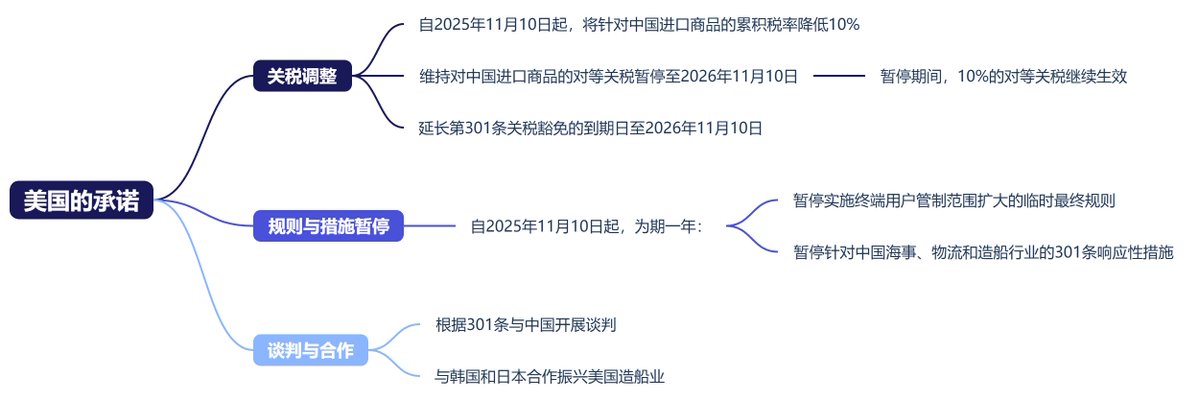Agreement on China-U.S. Economic and Trade Relations
China's Commitments:
China will suspend the implementation of global new export controls on rare earths and related measures announced on October 9, 2025.
China will issue general licenses for the export of rare earths, gallium, germanium, antimony, and graphite for U.S. end users and their global suppliers. This general license essentially means that the controls implemented by China in April 2025 and October 2022 will be lifted.
China will take significant measures to curb the flow of fentanyl into the United States. Specifically, China will stop shipping certain designated chemicals to North America and will implement strict controls on the export of certain other chemicals to all global destinations.
China will suspend all retaliatory tariffs announced since March 4, 2025. This includes tariffs on a large number of U.S. agricultural products: chicken, wheat, corn, cotton, sorghum, soybeans, pork, beef, seafood, fruits, vegetables, and dairy products.
China will suspend or cancel all retaliatory non-tariff countermeasures taken against the U.S. since March 4, 2025, including listing certain U.S. companies on its end-user and unreliable entity lists.
China will purchase at least 12 million tons of U.S. soybeans in the last two months of 2025, and at least 25 million tons of U.S. soybeans each year in 2026, 2027, and 2028. Additionally, China will resume purchases of U.S. sorghum and hardwood logs.
China will take appropriate measures to ensure that the Nexperia factory located in China resumes trade, allowing the output of key traditional process chips to flow to other parts of the world.
China will cancel measures taken in response to the U.S. 301 investigation targeting "China's dominance in the maritime, logistics, and shipbuilding industries" and will lift sanctions imposed on several shipping entities.
China will further extend the expiration date of its market-based tariff exemption program for imported goods from the U.S., and these exemptions will remain effective until December 31, 2026.
China will terminate various investigations against U.S. companies in the semiconductor supply chain, including antitrust, anti-monopoly, and anti-dumping investigations.
U.S. Commitments:
The U.S. will reduce the tariffs imposed on Chinese imports to curb the flow of fentanyl by lowering the cumulative tax rate by 10%, effective November 10, 2025.
The suspension of increased reciprocal tariffs on Chinese imports will be maintained until November 10, 2026. (During this suspension, the current 10% reciprocal tariff will continue to be in effect.)
The U.S. will further extend the expiration date of certain Section 301 tariff exemptions (currently set to expire on November 29, 2025) to November 10, 2026.
Effective November 10, 2025, for one year, the U.S. will suspend the implementation of a temporary final rule that expands the scope of end-user controls to cover certain listed entities' affiliates.
Effective November 10, 2025, for one year, the U.S. will suspend the implementation of responsive measures taken under the Section 301 investigation regarding China's "targeting of the maritime, logistics, and shipbuilding industries to seek dominance."
The U.S. will negotiate with China under Section 301 while continuing historic cooperation with South Korea and Japan to revitalize the U.S. shipbuilding industry.
Interpretation:
This agreement represents another phase of balance in China-U.S. trade, but I still feel that the relationship between China and the U.S. has a sense of superficial harmony. On one side is Yue Buqun, and on the other is Zuo Lengchan. The current agreement suggests that both sides are unwilling to let the situation spiral out of control. For the U.S., there is a need to curb inflation, stabilize supply chains, and appease agricultural and manufacturing votes.
China also needs a safety buffer for foreign trade and industrial chains to avoid being passively hindered at the juncture of global manufacturing system restructuring. Especially given China's current overall economic situation, which still requires development, a phased reconciliation with the U.S. can alleviate domestic discord.
However, from a long-term fundamental perspective, the contradictions between China and the U.S. have not been resolved.
This article is sponsored by #Bitget | @Bitget_zh



免责声明:本文章仅代表作者个人观点,不代表本平台的立场和观点。本文章仅供信息分享,不构成对任何人的任何投资建议。用户与作者之间的任何争议,与本平台无关。如网页中刊载的文章或图片涉及侵权,请提供相关的权利证明和身份证明发送邮件到support@aicoin.com,本平台相关工作人员将会进行核查。




